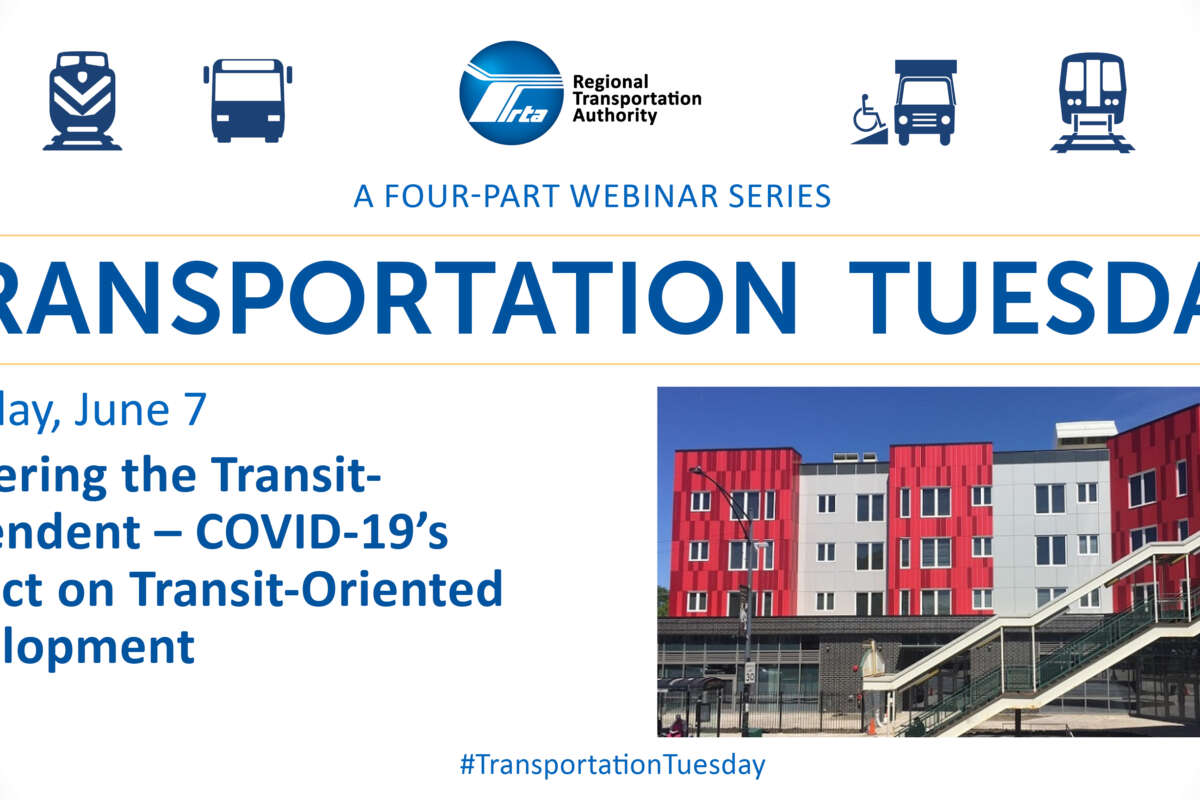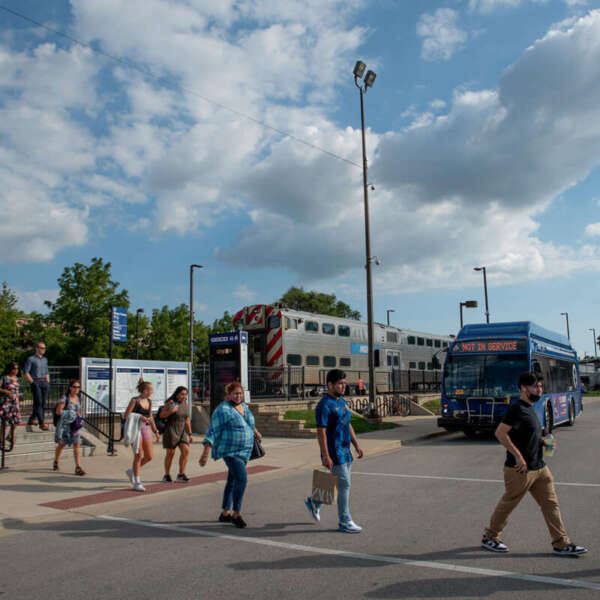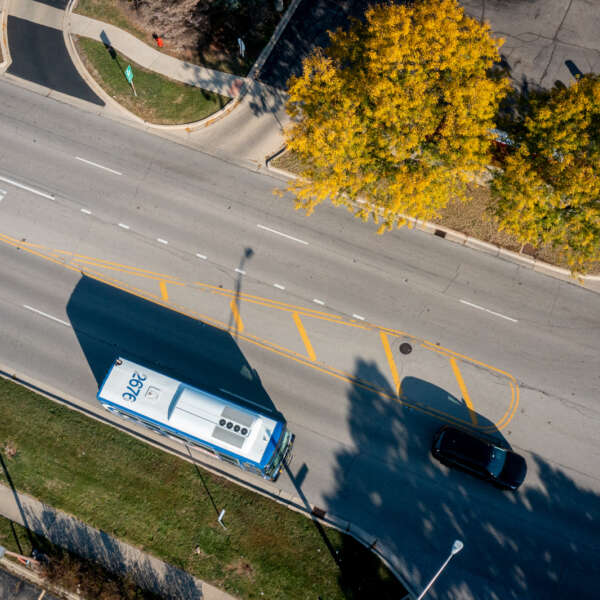Transportation Tuesday webinar explores centering the transit-dependent in TOD
June 10, 2022
June 10, 2022

Transit-oriented development (TOD) has successfully brought a mixture of residential, commercial, office, and public uses to transit station areas. How has the sustained decline of public transit ridership brought on by the COVID-19 pandemic changed the way planners, developers, and community groups think about TOD?
In the first webinar of the RTA’s four-part Transportation Tuesday Series, the panel, with representatives from Auburn Gresham, Skokie, Harvey, Highwood, and Preservation of Affordable Housing (POAH), discussed this question and more. Moderated by RTA senior planner Alex Waltz, the panel explored the importance of continued development near transit through an equity lens.
The conversation kicked off with an RTA data overview of the impacts of the COVID-19 pandemic on ridership in the region. The findings from the data revealed that while there was a steady decrease in transit riders, these patterns were not uniform across modes of transportation and locations.
“In Chicago, neighborhoods with higher shares of residents of color—such as largely Black and Hispanic residents on the city’s South and West sides—retained far more ridership at their 'L' stations than those in communities where white families predominate,” Waltz said.
The panel’s discussion centered around four topics: the community’s preferences for transit and land use, community engagement in TOD projects, the equitable distribution of TOD benefits, and investment interest and gentrification.
How have you changed the way you approach transit-oriented development since the COVID-19 pandemic began?
Carlos Nelson, CEO of the Greater Auburn Gresham Development Corporation, explained that prioritization has shifted to educating the residents on TOD. Nelson noted that while public transportation acts as a “great equalizer,” the successful integration of TOD in the neighborhood is dependent on addressing safe, comfortable access to transit.
For the city of Harvey, Director of Economic Development Nicholas Greifer noted that since the pandemic, efforts are being redirected to heavily focus on TOD. The city recently adopted a new TOD plan, developed with the RTA’s Community Planning department, that focuses on investment in the city’s transit infrastructure, improved connections for riders, and transformed public spaces.
Among the panelists, there was a strong consensus that while transit ridership has declined, TOD is a critical tool necessary for economic recovery and to address issues such as residential proximity to schools, restaurants, shops, and other amenities.
How do you describe TOD projects? What are residential concerns about new TOD projects?
Across the board, the panelists agreed that community engagement is critical to having a successful TOD project. Molly Ekerdt, Vice President of POAH Chicago, said they conduct a survey before starting a development project and participate in robust community engagement throughout the process. Nelson said residents on the South Side are concerned about the trustworthiness of developers because of the disinvestment they’ve experienced. To build trust, the City, planning agencies, and developers need to not only include the community, but see community members as leaders on these projects.
Panelists said that gentrification and displacement are often major resident concerns around TOD projects.
“The ‘G word,’ as we would call it, that conversation is held quite a bit,” Nelson said. “We certainly feel that when the redevelopment is done from inside out—by local developers, local [community development corporations], not-for-profits—that community ownership model is the way to stem the tide.”
Which types of developments do residents seem most interested in?
Scott Coren, City Manager of Highwood, said it’s important to strike a balance with TODs between what type of development is popular and what type of development is needed by the community. For example, small-scale retail is popular among residents, but the reality is that brick-and-mortar retailers struggle to be successful.
Carrie Haberstich, AICP, Planning Supervisor for the Village of Skokie, said residents aren’t necessarily concerned about or opposed to density, but there is often concern over building height. Getting the community on board with tall, dense buildings requires effective engagement.
Nelson said through the Greater Auburn Gresham Development Corporation quality of life planning process, residents expressed a desire for more healthy living resources, access to healthy food, and financial stability. A Healthy Lifestyle Hub will open in the neighborhood in July and will meet many of these needs.
While it seemed possible that the sustained decrease in transit ridership due to the COVID-19 pandemic would render TOD irrelevant, in reality TOD is still highly desired from an equity and economic development perspective. And although ridership declined across the region’s transit services, it declined less in communities of color, indicating that centering the transit-dependent in TOD is more important than ever—and that there is interest among planners, economic development experts, and community advocates to do just that.
Transportation Tuesday takes place every Tuesday in June. The webinar is free, but registration is required. Learn more about future events, and register to attend here.
Subscribe to our Newsletter
Related Articles
 Transit station activation in Uptown brings positive presence to Broadway bus route with weekly outdoor yoga class
Transit station activation in Uptown brings positive presence to Broadway bus route with weekly outdoor yoga class
On Friday mornings now through the end of the year, CTA #36 and #81 bus riders and Red Line passengers through the Uptown neighborhood of Chicago may catch a...
July 25, 2024 Join the RTA Transit is the Answer Coalition to discuss possible reforms to improve service and accountability for riders
Join the RTA Transit is the Answer Coalition to discuss possible reforms to improve service and accountability for riders
Following the introduction of legislation that proposes changes to how the Chicago region’s transit agencies are organized, the RTA continues to lead convers...
July 15, 2024 RTA releases new fare equity report, recommending fully funding and expanding reduced fare programs
RTA releases new fare equity report, recommending fully funding and expanding reduced fare programs
A new report released by the RTA in July, Building a More Equitable Fare Structure for Public Transit in the Chicago Region, recommends that the state legisl...
July 11, 2024 Homewood, Richton Park adopt transit-oriented development plans funded through RTA Community Planning program
Homewood, Richton Park adopt transit-oriented development plans funded through RTA Community Planning program
This spring, transit-oriented development (TOD) plans were adopted by the villages of Homewood and Richton Park that will make these communities more transit...
July 11, 2024 Good news: Regional transit ridership reaches new high as CTA, Metra, and Pace increase service, offer new fare products
Good news: Regional transit ridership reaches new high as CTA, Metra, and Pace increase service, offer new fare products
Ridership across Chicago’s transit system has continued to increase, with May 2024 seeing the highest ridership levels since 2019 for CTA, Metra, and Pace. T...
June 28, 2024 Legislative Update: Lawmakers pass state budget, action on transit funding still needed ahead of fiscal cliff
Legislative Update: Lawmakers pass state budget, action on transit funding still needed ahead of fiscal cliff
The Illinois General Assembly adjourned this year’s spring legislative session after passing an overall $53.1 billion budget for State Fiscal Year (SFY) 2025...
June 27, 2024